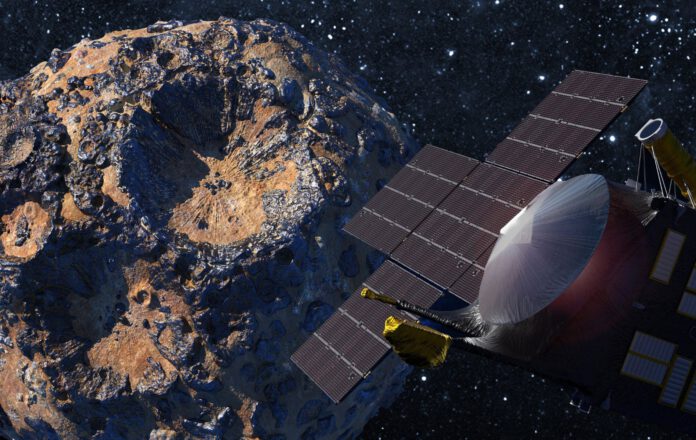
The final destination is the enigmatic asteroid Psyche, which hopefully can tell us more about the origins of Earth and other rocky planets.
In the region between the orbits of Mars and Jupiter, known as the asteroid belt, there are numerous space rocks, including the asteroid called Psyche. Psyche is a strange world because it is not made up mostly of rock or ice, but of metal. Scientists speculate that the space rock – like the core of the Earth – primarily contains iron and nickel. For years, NASA has been planning to pay this metal-rich world a visit. And that visit is finally about to happen. Because next week, the Psyche spacecraft will take off and head for the asteroid.
Launch
As it stands now, the spacecraft is scheduled for launch on Thursday, October 12, just after 16:15 CET, from launch complex 39A at NASA’s Kennedy Space Center in Florida. A SpaceX Falcon Heavy rocket will propel the Psyche spacecraft into space. The direct launch broadcast begins at 15:15 CET on the NASA Television media channel. You can also follow the launch on platforms including YouTube and Facebook.
Premiere
The mission to Psyche promises to be exciting. Scientists have already sent probes to rocky asteroids and icy comets. But now, a space probe is departing for the first time for a mysterious metal world. This is a real first. Researchers suspect that Psyche is likely composed of both rock and metal, with the metal accounting for somewhere between 30 percent and 60 percent of the total volume. Moreover, experts believe that Psyche may contain large quantities of metal from the core of a so-called planetesimal, one of the fundamental building blocks of our solar system. This asteroid is most likely a survivor of numerous violent collisions that often occurred during the formation of our solar system.
Objective
The purpose of the mission is to improve our understanding of the origins of Earth and other rocky planets. Scientists suspect that Psyche may be the remnant of the core of a planet-like body. In other words, the asteroid may represent the exposed core of a protoplanet, which somehow lost its rocky surface layers. By studying the asteroid, astronomers hope to gain more insight into this process. In essence, the journey of the Psyche spacecraft to the eponymous asteroid is somewhat akin to a journey to the core of the Earth. The mission can tell us much about the early history and formation of the Earth’s core and the cores of other rocky planets in our solar system.
The mission is particularly special because it gives us the first ever opportunity to study a ‘metal core’ which is usually hidden deep inside earth-like planets. For example, the Earth’s core is inaccessible, concealed far beneath rocky mantles and crusts. The asteroid Psyche will therefore provide us with a unique insight into the building blocks of planet formation and open the door to studying a hitherto unknown world. A journey to Psyche will give us a rare insight into the tumultuous history of collisions and the accretion of matter responsible for the formation of planets like ours. But even if scientists conclude that Psyche is not an exposed core, the asteroid remains fascinating. In that case it could be an even rarer type of primitive object in our solar system, something never observed before.
Characteristics
In addition, NASA hopes to unravel some more characteristics of Psyche. What we know so far is that the asteroid is strikingly large, with a diameter of no less than 210 kilometers. But that’s about it. When we look at images from telescopes, Psyche appears as a faint spot that we can barely locate from Earth. Scientists have been able to glean some information from radar data, such as that the asteroid somewhat resembles a potato and rotates on its side, but much mystery remains surrounding Psyche. We’ll only truly know what this hefty space rock looks like when the probe brings it into close-up view for the first time.
But that will take some time. It’s expected the spacecraft will be on its way for almost six years and won’t arrive at the asteroid until 2029. After its launch from NASA’s Kennedy Space Center, the probe will swing by our nearest neighbor Mars about seven months later. The probe will leverage Martian gravity to sling itself towards the asteroid, hundreds of millions of kilometers away. In total, the vessel will travel around 3.6 billion kilometers.
Upon arrival, the spacecraft will orbit around the asteroid for approximately 26 months, studying it up close with various instruments such as a multispectral imager, a gamma-ray and neutron spectrometer, and a magnetometer.
Mapping
We will need a fair amount of patience before the first results trickle in. But when the day comes, we can prepare ourselves for quite a spectacle. The probe will orbit around the asteroid for two years, taking photos, mapping the surface, and gathering data to determine the composition of Psyche. As soon as the spacecraft gets the asteroid in sight, it will immediately send images back to Earth. And then, finally, we will discover what that faint, blurry spot that we currently observe through our telescopes actually looks like. For the first time, the details of the surface of this mysterious and distant world will be revealed.
Researchers are eagerly anticipating next week’s launch. “Whenever new research results about Psyche are published, it seems to raise more questions,” says researcher Anicia Arredondo. “The asteroid seems extraordinarily complex and probably has numerous surprises in store. The possibility of the unexpected is one of the most exciting aspects of studying an as-yet-unknown object. We therefore look forward to gaining deeper insight into the origins of Psyche.”











